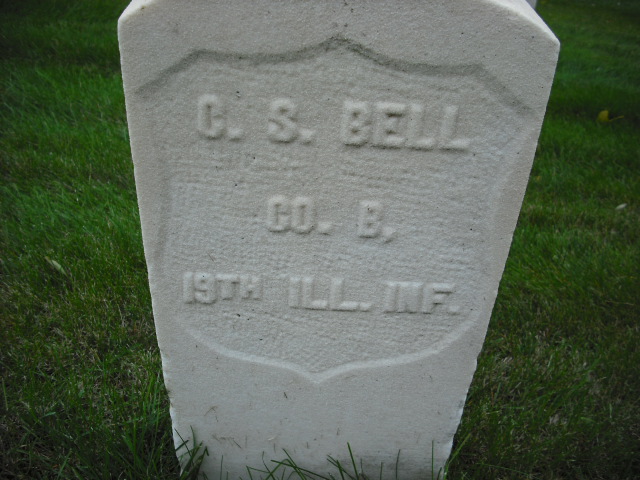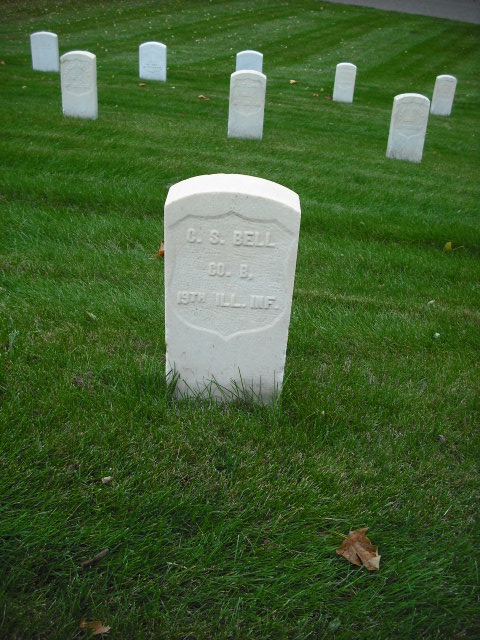Captain Charles S Bell served in the Union Army as a spy under General J J Reynolds. He was captured behind enemy lines but managed to escape. After the war General Reynolds commanded the occupation forces in southwest, including the Department of Texas. Bell applied for a job as "detective" with the general and was placed in a position to wage war against the Taylors in the Sutton-Taylor Feud. In June of 1868 Bell was teamed with a fellow by the name of Jack Helms and for the next few months waged a reign of terror in South Texas against what they mistakenly believed to be horse thieves and desperadoes. The number of men killed is not known for sure, but the number of fifty is believed to fairly accurate. The posses under Bell and Helms became known as the "regulators" and one of the most murderous members was the infamous John Wesley Hardin. Helms was informed that Bell had been killed in a gunfight with five men near the Guadalupe River and that a body had been in the river along with his silver-handled pistol with "C S Bell" engraved on it. A short time later he was spotted on the streets of Austin proving the report was bogus. Bell was denied the new post of Adjutant General of the State Militia and State Police and became an embarrassment to the state Republican Party. Exactly when he decided to leave the state is not known for sure but he worked his way across the south and settled in Washington, DC for a time. Meanwhile back in Texas he was indicted for murder for the death of some of the Regulator's victims. A detective, James F Cunningham, captured him in Mississippi but a judge decided the arrest papers were fraudulent. Bell was afraid that if Cunningham was to take him back to Texas he would be shot while "trying to escape," a favorite ploy of the Regulators. By early 1879 he was suffering from consumption and moved to Dayton Ohio where he became a resident of the Soldiers' Home where he died.
Captain Charles S Bell served in the Union Army as a spy under General J J Reynolds. He was captured behind enemy lines but managed to escape. After the war General Reynolds commanded the occupation forces in southwest, including the Department of Texas. Bell applied for a job as "detective" with the general and was placed in a position to wage war against the Taylors in the Sutton-Taylor Feud. In June of 1868 Bell was teamed with a fellow by the name of Jack Helms and for the next few months waged a reign of terror in South Texas against what they mistakenly believed to be horse thieves and desperadoes. The number of men killed is not known for sure, but the number of fifty is believed to fairly accurate. The posses under Bell and Helms became known as the "regulators" and one of the most murderous members was the infamous John Wesley Hardin. Helms was informed that Bell had been killed in a gunfight with five men near the Guadalupe River and that a body had been in the river along with his silver-handled pistol with "C S Bell" engraved on it. A short time later he was spotted on the streets of Austin proving the report was bogus. Bell was denied the new post of Adjutant General of the State Militia and State Police and became an embarrassment to the state Republican Party. Exactly when he decided to leave the state is not known for sure but he worked his way across the south and settled in Washington, DC for a time. Meanwhile back in Texas he was indicted for murder for the death of some of the Regulator's victims. A detective, James F Cunningham, captured him in Mississippi but a judge decided the arrest papers were fraudulent. Bell was afraid that if Cunningham was to take him back to Texas he would be shot while "trying to escape," a favorite ploy of the Regulators. By early 1879 he was suffering from consumption and moved to Dayton Ohio where he became a resident of the Soldiers' Home where he died.
Family Members
Advertisement
Advertisement








